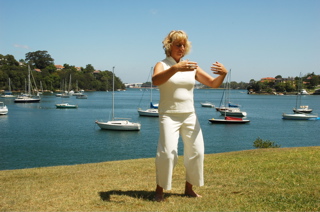Qi Gong Basics Part 2
Breathing
Have you ever watched a baby breathing – their belly rises and falls as they breathe in and out. This is what the Chinese consider to be our natural breath and this is how we breathe in Qi Gong.
While standing as above place your hands over your lower abdomen just below your belly button – women place right hand over left and men opposite. Begin to breathe in while expanding your lower abdomen, feel your hands being pushed outwards, then as you breathe out let your abdomen relax and gently contract inwards. Breathe in and out through your nose; do not force your breath keep it natural. Continue to breathe in this fashion throughout the whole exercise.
Connecting the Small Heavenly Cycle
While standing and breathing as above, place your tongue onto the roof of your mouth, just wherever it feels comfortable. This action acts like a switch to connect two meridians: Ren Mai [Conception Vessel] which travels from the base of the body up the centre-line to the bottom lip; and Du Mai [Governing Vessel] which emerges from the same point at the base of the body and travels up the spine, over the head and ends at the top lip. During the practise of QI Gong you will activate the movement of Qi through these meridians and cause these two meridians to merge and flow as a cycle around the body.
 Holding the Ball to Strengthen the Body and Cultivate Qi
Holding the Ball to Strengthen the Body and Cultivate Qi
This first exercise is very powerful and while it may seem quite simple, just try to do it for 5 minutes and then think about how simple it is! There is a saying in Taoist philosophy, “Do nothing and everything is done”. In this exercise apparently you are doing nothing, but as you will soon discover there is a lot going on – inside!
Part 1: Begin by standing and breathing as above, with your tongue on the roof of your mouth. Now slightly bend your knees, as if you are resting your bottom on the edge of a bench. Your knees must be in line with your toes; tilt your hips slightly back and your bottom slightly forward. This should cause your lower back to relax. Your back is straight and your head upright.
Part 2: Gently raise your arms up in front of you as if they are holding a big ball that fits between your hands and chest. The palms of your hands face your chest and your elbows are dropped down slightly. Your arms and shoulders must be completely relaxed. If it helps you may imagine that your elbows are resting on big balloons and that your arms are being held up by helium-filled balloons, also that you are sitting on a big ball.
By this time, if this is new to you, your thighs should be starting to ache and if not then you are not bending them enough, so sit down a little further. This is the most important part of this exercise as it is this posture that actually helps to generate Qi. You may also be starting to sweat slightly and you should be feeling your heart and pulse rate increase. Now your arms will start to ache too and here comes the next most important part of the exercise – ignore the pain and keep breathing slowly and deeply, at least for a couple of minutes because you see this is where you also get to train your mind.
If you give in to your mind saying “this is too hard”, “I’m in pain”, “this hurts” and you stop, then you will never cultivate your Qi. Given that you have no physical disability that prevents you from doing these movements [or postures] then in time the pain will decrease just like any sport or exercise as your muscles gets used to it. Begin with just a minute or two a day, slowly building it up to 10 minutes and eventually to 20 minutes. Try to do it without any external distraction, like music or tv or radio. Simply focus on your breathing and the benefit you are giving your body.
To finish, gently lower your arms and slowly straighten your legs, place your hands over your lower abdomen as above, continue to breathe slowly and deeply while mentally scanning your body for areas of tension. Keep your mind on those areas for a few moments while breathing and imagine them relaxing.
As simple and straightforward as this may seem, this is one of the most powerful Qi Gong exercises you can do. It generates Qi as well as allows the Qi to flow harmoniously throughout the body. The next exercise is less strenuous yet equally beneficial.